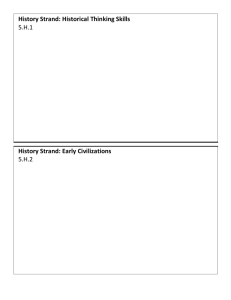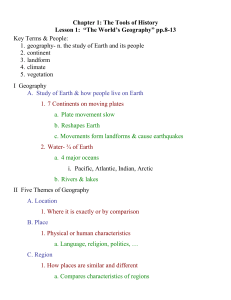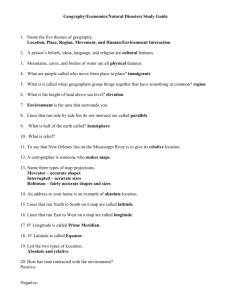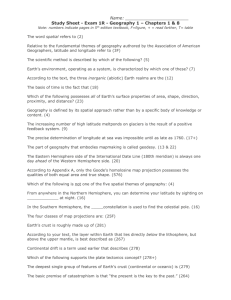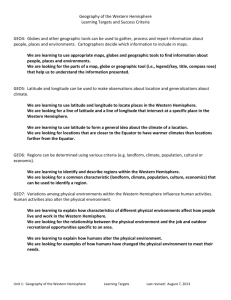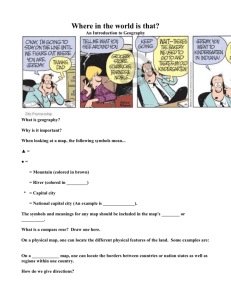Old and New Social Studies Standards
advertisement
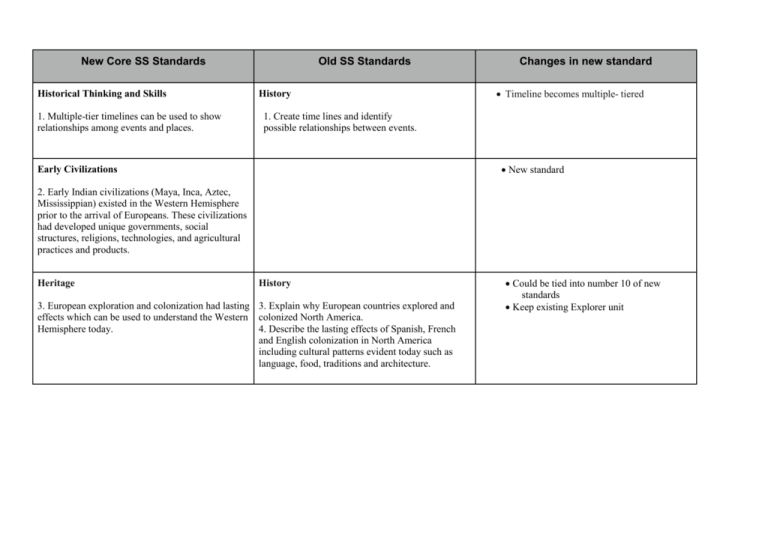
New Core SS Standards Historical Thinking and Skills 1. Multiple-tier timelines can be used to show relationships among events and places. Old SS Standards History Changes in new standard Timeline becomes multiple- tiered 1. Create time lines and identify possible relationships between events. New standard Early Civilizations 2. Early Indian civilizations (Maya, Inca, Aztec, Mississippian) existed in the Western Hemisphere prior to the arrival of Europeans. These civilizations had developed unique governments, social structures, religions, technologies, and agricultural practices and products. Heritage History 3. European exploration and colonization had lasting 3. Explain why European countries explored and effects which can be used to understand the Western colonized North America. Hemisphere today. 4. Describe the lasting effects of Spanish, French and English colonization in North America including cultural patterns evident today such as language, food, traditions and architecture. Could be tied into number 10 of new standards Keep existing Explorer unit Geography 1. Use coordinates of latitude and longitude to determine the absolute location of points in North America. 2. Use maps to identify the location of: a. The three largest countries of North America; b. The 50 states of the United States; c. The Rocky and Appalachian mountain systems; d. The Mississippi, Rio Grande and St. Lawrence rivers; e. The Great Lakes. Places and Regions History Can tie into a geography unit along with States and Regions 6. Regions can be determined using data related to various criteria including landform, climate, population, and cultural and economic characteristics. 6. Explain the impact of settlement, industrialization and transportation on the expansion of the United States. Connects with new standard 9 Spatial Thinking and Skills 4. Globes and other geographic tools can be used to gather, process and report information about people, places and environments. Cartographers decide which information to include in maps. 5. Latitude and longitude can be used to make observations about location and generalizations about climate. New standard does not list specific landforms but use old standards to guide Latitude and longitude need to be introduced Geography 3. Describe and compare the landforms, climates, population, culture and economic characteristics of places and regions in North America. 5. Explain, by identifying patterns on thematic maps, how physical and human characteristics can be used to define regions in North America. Human Systems Geography 7. Variations among physical environments within the Western Hemisphere influence human activities. Human activities also alter the physical environment. 8. Explain how the characteristics of different physical environments affect human activities in North America. 9. Analyze the positive and negative consequences of human changes to the physical environment including: Human Systems History 8. American Indians developed unique cultures with many different ways of life. American Indian tribes and nations can be classified into cultural groups based on geographic and cultural similarities. 2. Explain how American Indians settled the continent and why different nations of Indians interacted with their environment in different ways. Human Systems Geography 9. Political, environmental, social and economic factors cause people, products and ideas to move from place to place in the Western Hemisphere today. 8. Explain how the characteristics of different physical environments affect human activities in North America. Human Systems People in Societies 10. The Western Hemisphere is culturally diverse due to American Indian, European, Asian and African influences and interactions, as evidenced by artistic expression, language, religion and food. 1. Compare the cultural practices and products of diverse groups in North America including: a. Artistic expressions; b. Religion; c. Language; d. Food; e. Clothing; f. Shelter. Should be taught with new standard 2 Connects with new standard 7 Adding Asian culture African influence of slavery is not included except in this standard Civic Participation and Skills Social Studies Skills and Methods 11. Individuals can better understand public issues by gathering and interpreting information from multiple sources. Data can be displayed graphically to effectively and efficiently communicate information. 2. Locate information in a variety of sources using key words, related articles and cross-references. 8. Communicate research findings using line graphs and tables. Roles and Systems of Government Government 12. Democracies, dictatorships and monarchies are categories for understanding the relationship between those in power or authority and citizens. 2. Explain the essential characteristics of American democracy including: a. The people are the source of the government's authority. b. All citizens have the right and responsibility to vote and influence the decisions of the government. c. The government is run directly by the people or through elected representatives. d. The powers of government are limited by law. e. Basic rights of individuals are guaranteed by the Constitution. Economic Decision Making and Skills 13. Information displayed in circle graphs can be used to show relative proportions of segments of data to an entire body of data. Old standards will be review, to add systems of government New standard, but other charts can still be incorporated throughout the year Economic Decision Making and Skills 14. The choices people make have both present and future consequences. Geography 9. Analyze the positive and negative consequences of human changes to the physical environment including: Study Skills 9. Use a problem-solving/decision-making process which includes: a. Identifying a problem; b. Gathering information; c. Listing and considering options; d. Considering advantages and disadvantages of options; e. Choosing and implementing a solution; f. Developing criteria for judging its effectiveness; g. Evaluating the effectiveness of the solution. Scarcity 15. The availability of productive resources (i.e., human resources, capital goods and natural resources) promotes specialization that leads to trade. Production and Consumption 16. The availability of productive resources and the division of labor impact productive capacity. Economics 5. Explain the general relationship between supply, demand and price in a competitive market. 6. Explain why competition among producers/sellers results in lower costs and prices, higher product quality, and better customer service. 7. Explain why competition among consumers/buyers results in higher product prices. Economics 2. Explain that individuals in all economies must answer the fundamental economic questions of what to produce, how to produce, and for whom to produce. 3. Explain how education, specialization, capital goods and the division of labor affect productive capacity. Use old standards to help show how to make choices Markets 17. Regions and countries become interdependent when they specialize in what they produce best and then trade with other regions to increase the amount and variety of goods and services available. Geography 7. Analyze reasons for conflict and cooperation among regions of North America including: a. Trade; b. Environmental issues; c. Immigration. Economics 4. Explain how regions in North America become interdependent when they specialize in what they produce best and then trade with other regions inside and outside North America to increase the amount and variety of goods and services available. Financial Literacy New standard 18. Workers can improve their ability to earn income by gaining new knowledge, skills and experiences. History 5. Explain how the United States became independent from Great Britain. People in Societies 2. Compare life on Indian reservations today with the cultural traditions of American Indians before the reservation system. 3. Describe the experiences of African-Americans under the institution of slavery. 4. Describe the waves of immigration to North America and the areas from which people came in each wave. 5. Compare reasons for immigration to North America with the reality immigrants experienced upon arrival. Changes to peel away throughout the next 3 years Some are specific that will be included in the broader conversations of the new standards Geography 6. Use distribution maps to describe the patterns of renewable, nonrenewable and flow resources in North America including: a. Forests; b. Fertile soil; c. Oil; d. Coal; e. Running water. 10. Use or construct maps of colonization and exploration to explain European influence in North America. Economics 1. Compare different allocation methods for scarce goods and services such as prices, command, first-come-first-served, sharing equally, rationing and lottery. Government 1. Explain major responsibilities of each of the three branches of the U.S. government: a. The legislative branch, headed by Congress, passes laws. b. The executive branch, headed by the president, carries out and enforces the laws made by Congress. c. The judicial branch, headed by the Supreme Court, interprets and applies the law. 3. Explain the significance of the Declaration of Independence and the U.S. Constitution. Citizenship Rights and Responsibilities 1. Explain how an individual acquires U.S. citizenship: a. Birth; b. Naturalization. 2. Explain the obligations of upholding the U.S. Constitution including: a. Obeying laws; b. Paying taxes; c. Serving on juries; d. Registering for selective service. 3. Explain the significance of the rights that are protected by the First Amendment including: a. Freedom of religion; b. Freedom of speech; c. Freedom of the press; d. Right of petition and assembly. Social Studies Skills and Methods 1. Obtain information from a variety of print and electronic sources and analyze its reliability including: a. Accuracy of facts; b. Credentials of the source. 3. Differentiate between primary and secondary sources. 4. Read information critically in order to identify: a. The author; b. The author's perspective; c. The purpose. 5. Compare points of agreement and disagreement among sources. 6. Draw inferences from relevant information. 7. Organize key ideas by taking notes that paraphrase or summarize.
